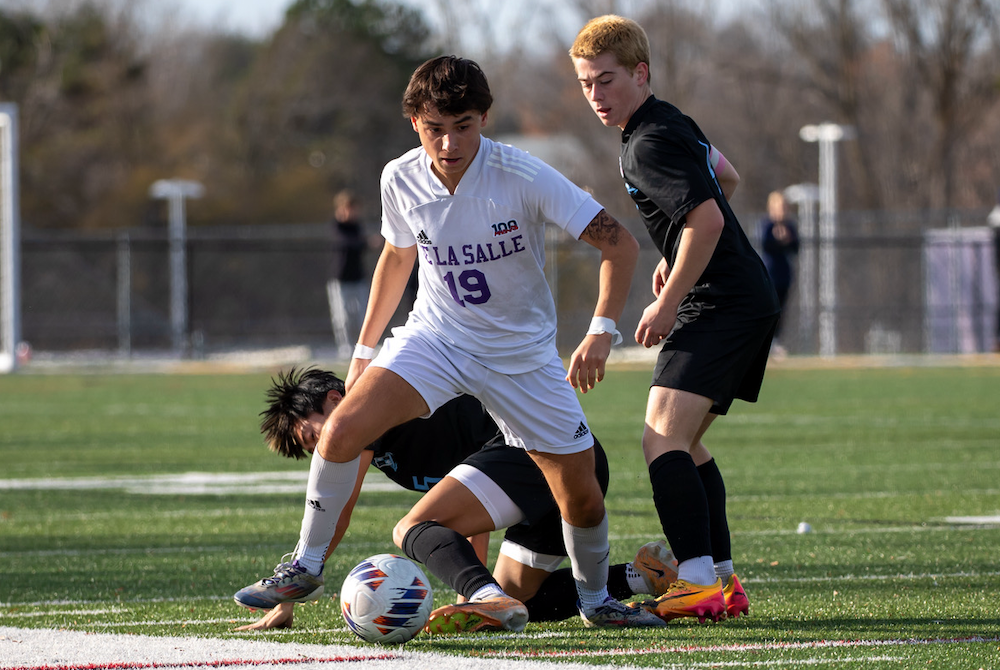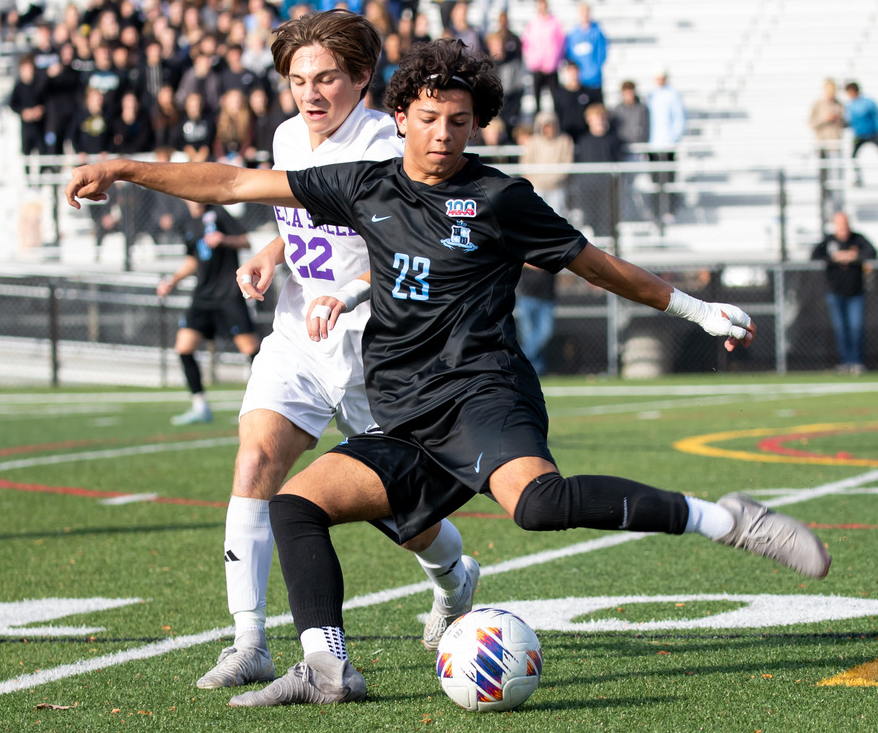
Classes Still Create Hoosier Hysteria
July 27, 2017
By Rob Kaminski
MHSAA benchmarks editor
This is the fourth part in a series on MHSAA tournament classification, past and present, that will be published over the next two weeks. This series originally ran in this spring's edition of MHSAA benchmarks.
Twenty years ago, Bloomington North High School won the Indiana High School Athletic Association boys basketball championship, defeating Delta 75-54 at the RCA Dome in Indianapolis.
The date, March 22, 1997, is at the same time revered and disdained by traditionalists in the state who saw it as the last schoolboy championship game the state would ever host.
That’s how devout the game of basketball, particularly interscholastic basketball, had become in the Hoosier state during the 87 years a state champion – one state champion, to be precise – was crowned.
Following that 1997 season, the IHSAA moved to a four-class system for its roundball tournaments, like so many of its state association counterparts had done years earlier.
It would be shocking to find more than a small percentage of current high school basketball players around the country unfamiliar with the iconic movie Hoosiers, even though the film is now more than 30 years old.
And, the storyline for that blockbuster unfolded more than 30 years prior to its release, when small-town, undermanned Milan High School defeated Muncie Central High School 32-30 in the 1954 IHSAA title game.
Perhaps it’s because of the David vs Goliath notion, or the fame of the movie that replaced Milan with the fictional Hickory and real-life star Bobby Plump with Hollywood hero Jimmy Chitwood, or the simple fact that Indiana had something other states didn’t.
Whatever the reason, plenty of opposition remains to this day to basketball classification in the state.
The fact is, the small rural schools were regularly being beaten handily by the much larger suburban and city schools as the tournament progressed each season.
Small schools also were closing at a rapid rate following the state’s School Reorganization Act in 1959, as students converged on larger, centralized county schools. From 1960 to 2000, the number of schools entering the tournament dropped from 694 to 381, and in 1997 a total of 382 schools and 4,584 athletes began competition at the Sectional level (the first level of the IHSAA Basketball Tournament).
It was at the entry level of the tournament where school administrators felt the pain of the new class system, but not necessarily for the same nostalgic reasons as the fans who either attended or boycotted the tournament.
At the Sectional round of the tournament, the IHSAA was culling just 2 percent of the revenue, with the participating schools splitting the balance. So, when Sectional attendance dropped by 14 percent in that first year of class basketball, many schools realized a financial loss. It was money they had grown to count on in prior years to help fund various aspects of the department.
Schools cumulatively received more than $900,000 from Sectional competition in 1998, but that total was down from more than $1 million in the last year of the single-class tournament.
Yet, the current format provides a great deal more opportunity and realistic chances at championship runs for schools of all enrollments.
To date, 60 additional teams have championship or runner-up trophies on display in school trophy cases around Indiana.
That was the mission in front of then-IHSAA commissioner Bob Gardner (now National Federation executive director) once the board made its decision: to give thousands more student-athletes the opportunity for once-in-a-lifetime experiences.
As any statistician knows, figures can be manipulated to tell any side of a story. Declining attendance in year one of class basketball is such a number.
The truth is tournament attendance had been on a steady downward spiral since its peak of just over 1.5 million in 1962. By the last single-class event in 1997, the total attendance was half that.
The challenge then and today, as it is for all state associations, is to find that delicate balance for those holding onto tradition, those holding onto trophies, and the number of trophies to hand out.
Editor’s Note: Stories from the Fort Wayne Journal Gazette in 1998 and from a 2007 issue of Indianapolis Monthly provided facts in this article.

De La Salle Collegiate Takes Final Step to Finish 1st Title Run since 2005
By
Paul Costanzo
Special for MHSAA.com
November 2, 2024
GRAND LEDGE – Josh Ross made it to the final game of his high school soccer career without getting a single yellow card.
But Saturday, when his late goal sealed Warren De La Salle Collegiate’s Division 2 Final against Grand Rapids Forest Hills Northern, the senior midfielder figured it was OK to break that streak.
Ross ripped off his jersey and ran to the De La Salle student section to start off a celebration 19 years in the making.
“It was my first yellow card of my entire career,” said Ross, who was carded as jersey removal is an automatic card. “We were talking about it on the bus, we were joking that I was going to get my first yellow card taking my shirt off, and man, that was the greatest feeling that I could ever feel.”
De La Salle defeated Northern 4-1 to claim the sixth Finals title in program history, but first since 2005. Coach Thaier Mukhtar has been at the helm for all of those titles, and was emotional after this latest one.
“This is my sixth state championship – I’ve been there, I’ve done that,” he said. “But my tears were for my seniors. I couldn’t be happier for them.”
 The Pilots had 10 seniors on their roster, one year after having none. But a young group a year ago advanced to the Semifinals before getting knocked out in penalty kicks, and that helped push them throughout this season.
The Pilots had 10 seniors on their roster, one year after having none. But a young group a year ago advanced to the Semifinals before getting knocked out in penalty kicks, and that helped push them throughout this season.
“We had a rough start to (2023), but our group is so close,” said Ross, who had two goals and two assists. “Even though I’m a senior, I feel like I’m in the same grade as the sophomores and juniors. We’re a close group of boys that really nothing can stand in our way. Once we figured that out last year and started our run, started our roll, we got unlucky and lost in pens. But we knew how close we were, we knew how good we were, and as you see, we came out here and won today.”
De La Salle spent much of the game holding onto a 2-1 lead, as a frenetic start saw three goals scored in the game’s first 23 minutes. Neither team would find the net again, however, until Ross’ goal with 3:36 to play put the game on ice, and an Andrew Corder goal 1:26 later erased any doubt.
“The biggest weight off my shoulders ever,” Ross said. “One of the greatest feelings in my life.”
While the game was just a shot away from being tied for the majority of the second half, the Huskies weren’t able to create consistent pressure or the big chances that could test De La Salle goalkeeper Dominic Baldarotta, who stopped one of the two shots the Huskies put on frame.
The Pilots (20-3-1), meanwhile, had seven shots on frame, but just three of them coming in the second half, including the two goals in the final 3:36.
The lack of scoring chances in the second was a stark contrast to the first half, when it looked like a wide open game could be unfolding.
 De La Salle created the game’s first chance in the first 20 seconds after a quick free kick, and it scored the first goal 10:01 into the game as JJ Jurczyk finished off a Ross pass following a well-worked play on a corner kick.
De La Salle created the game’s first chance in the first 20 seconds after a quick free kick, and it scored the first goal 10:01 into the game as JJ Jurczyk finished off a Ross pass following a well-worked play on a corner kick.
It only took 1:04 for Northern to answer, however, as Dylan Van Skiver scored on a free kick to tie the game.
Ross’ first goal of the game didn’t come for another 11 minutes, but both teams had pushed through that timeframe. The goal, though, was worth the relatively short wait, as Corder played a gorgeous pass to spring Ross on goal, and the senior went to the far post for a 2-1 lead.
“I saw both the defenders closing me down,” Corder said. “(The) split, I practice that at Rondos at practice every day. So I put it through and just played him.”
Ross had an assist on Corder’s second goal, while Settimo Leone had an assist on Ross’ second.
“(Ross) was extremely motivated this year to lead this team to a championship,” Mukhtar said. “He’s a two-year captain, first-team all-state last year, he’ll be first-team all-state this year, obviously. He’s just a tremendous leader. He’s the type of kid you want to adopt. He’s extremely polite – except for taking off his shirt. I guess I won’t yell at him about that; he’s done.”
Goalkeeper Lukas Darling had three saves for Northern (19-5-3), which was playing in its first Final since winning it all in 2019.
PHOTOS (Top) De La Salle’s Vince Houlihan (19) controls the ball while two Forest Hills Northern players attempt to gain possession. (Middle) FHN’s Drin Mandija (23) winds up to send the ball forward with the Pilots’ Josh Ross in pursuit. (Below) De La Salle’s Andrew Corder maintains possession. (Photos by Adam Sheehan/Hockey Weekly Action Photos.)

